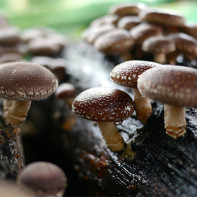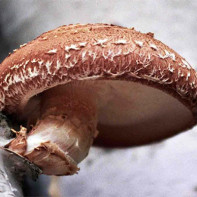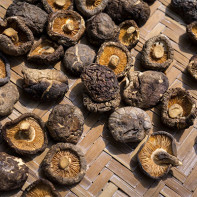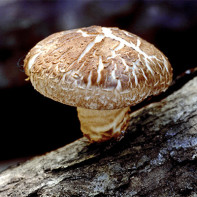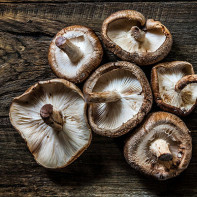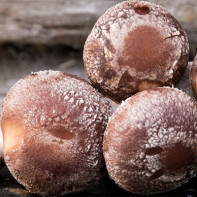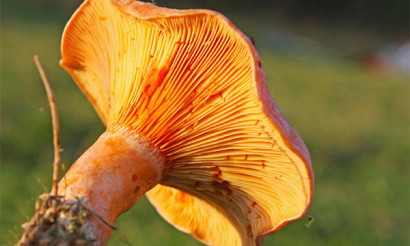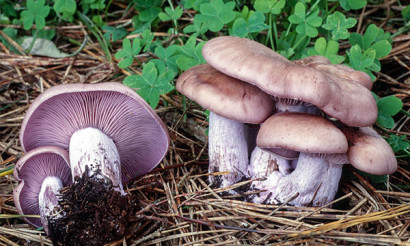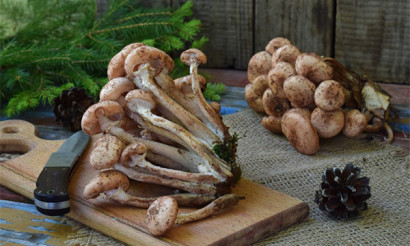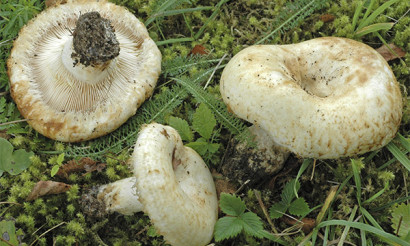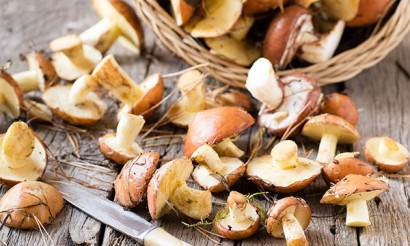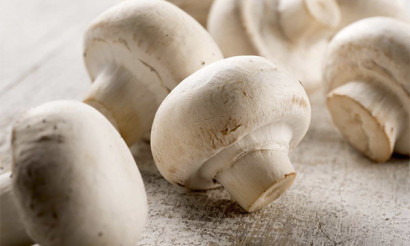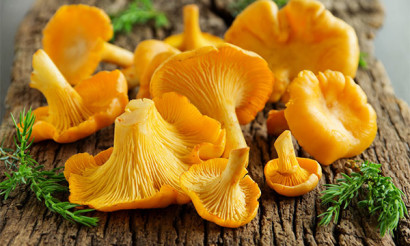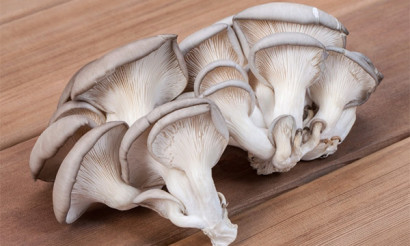Shiitake mushrooms: health benefits and harms
Shiitake lamellae, called shiitake in our area, are an exotic product. But this tree mushroom has already managed to gain immense popularity in various fields: cosmetology, pharmacology, cooking. The name derived from the shea tree, on the dead wood of which the mushroom grows, is not the only one. It is also called the "black forest" or "Japanese" mushroom, and the scientific name sounds like Lentinus edodes.
- Where Shiitake Mushrooms Grow
- Composition and calorie content
- The beneficial properties of shiitake mushrooms
- The benefits of shiitake while losing weight
- The use of shiitake in medicine
- How to make tincture
- Shiitake Extract
- Shiitake in cosmetology
- Harm and contraindications
- How to choose and store shiitake
- How to cook shiitake mushrooms: recipes
- Shiitake Pickled
- Crisps
- Pilaf with Shiitake
- Is it possible to eat raw shiitake
- Interesting Shiitake Facts
Shiitake has a light brown hat with a fringe around the edges. The surface of the hat is strewn with whitish plates. The height of the stalk reaches 2 centimeters, the diameter of the cap is 25, but more often mushrooms with 5-10 centimeters are gathered. The support fibers with a cream color, when pressed, acquire a brown color. The hat has a milky flesh.
Where Shiitake Mushrooms Grow
The habitat of shiitake is the southeastern regions of Asia. The fungus is found everywhere in China, Korea, Japan and some small countries in the region. In the Asian part of Russia, the mushroom was found in the natural environment of the Far East and Primorsky Territory.
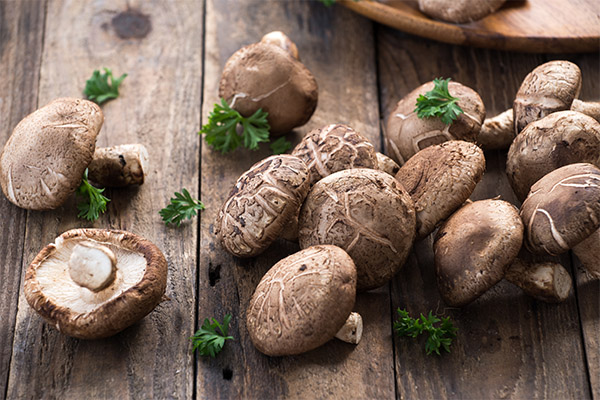
The history of Shiitake cultivation for food purposes dates back more than 2 thousand years. Over time, crop production has spread throughout the world. Today, shiitake cultivation is about half a million tons annually, with more than 30% of all production in mainland Europe. The leader is Japan, which produces mushrooms for export and for domestic use.
Traditional medicine recognized shiitake as an “elixir of life”: it is able to not only strengthen the body, but also relieve it of a number of specific diseases from which a significant proportion of humanity suffers.
Composition and calorie content
Shiitake is comparable in taste to porcini mushrooms or champignons, and due to its unique composition it is classified as a delicacy and is used to make soups, side dishes, salads, and is also used in raw and extracted form.
Shiitake mushrooms are distinguished by their unique rich composition, which has high nutritional value for the body. The main components of the product:
- Copper is a microelement whose content in this type of mushroom is kept at a level of more than 80%. It is important for metabolic processes in the body, in which iron is involved, providing oxygen to organs and tissues.
- Selenium - contained at the level of 45%, affects the condition of the skin and hair integument, as well as the deep nutrition of cells.
- Pantothenic acid (B5) - in the composition of about 70%. It is important as a participant in cholesterol metabolism, all cycles of the conversion of proteins, fats and carbohydrates, as well as a catalyst for the absorption of amino acids in the intestines.
- Choline - a substance that provides nutrition to brain cells, is involved in the exchange of all organic compounds that enter the body with food. It is found in shiitake at the level of 16%. This fact determines the widespread use of mushrooms in the rejuvenating and health-improving direction.
- Zinc is an important element for metabolism; it is about 11% in mushrooms.
Also, shiitake are characterized by a high level of fiber, vitamins of group B, A in the composition. Among macro- and microelements phosphorus, sodium, magnesium, calcium, potassium, manganese, and iron are represented.
The nutritional value of shiitake is from 34 to 56 kcal per 100 grams, depending on the method of preparation of the product.
Proteins, fats and carbohydrates in each fungus are distributed in a ratio of 1 / 0.1 / 7.7.
The beneficial properties of shiitake mushrooms
The beneficial effects of shiitake are multifaceted, as they:
- They fit perfectly into any diet, as they are a low-calorie product.
- They improve the conductivity of nerve fibers and help withstand stress.
- Reduce blood cholesterol.
- They contribute to the acceleration of metabolic processes, increase the enzymatic activity of liver enzymes, and, as a result, improve their cleavage ability.
- They participate in the elimination of decay products and toxins from the body due to the choleretic effect.
- Recommended for people with diabetes because they lower blood sugar.
- Infectious diseases are treated (in Chinese medicine).
Important! The long-term positive effect of the use of shiitake is noticeable only if the principles of proper nutrition and a healthy lifestyle are observed.
The benefits of shiitake while losing weight
Shiitake are a key component of the popular mushroom diet, known as the Yamakiro System, which is used to achieve quick results, as well as in a number of fungi (in the menu of which mushrooms are the main component).
The main purpose of using this type of mushroom for weight loss is to normalize metabolic processes in the body, as well as stimulate the liver's ability to remove toxins and toxins.
Nutritionists recommend combining the use of shiitake with additional physical activity and follow a diet regimen for a long period of time. In this case, you can achieve a noticeable and lasting result, as well as saturate the body with nutrients and increase immunity.
For weight loss, shiitake are used both in raw form and in powder form, which is added to main dishes or used to prepare drinks.
The use of shiitake in medicine
Shiitake is famous not only for its nutritional value, but also for its pharmaceutical properties, which made their use as a medicine popular. In Europe, such as Germany, France, Great Britain, and also in Japan, a number of preparations based on these mushrooms have been patented, which are used to treat viral and cancer diseases.
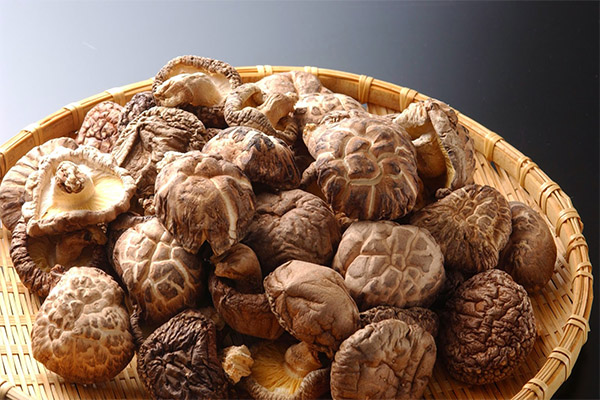
The most active substance isolated from the shiitake fruit body is known. This is lentinan - a polysaccharide that has the property to inhibit the development of tumors and stimulates the body's immune response.
This type of mushroom is able to increase the activity of interferon production in the body, with which its antiviral properties are associated. In addition to the fact that there is no cholesterol in shiitak, the use of these mushrooms leads to a decrease in its concentration in the blood. This, in turn, prevents atherosclerosis and stabilizes pressure. The treatment of hypertension is possible with the help of “Eritadenine” - a medicine based on lentinacin obtained from shiitake.
How to make tincture
Mushrooms can be infused, thus obtaining a product with all the nutrients contained in the original product in a concentrated form. From shiitake receive oil or alcohol tincture. As raw materials, powdered mushrooms are usually used.
Before using tinctures, consider contraindications for its use:
- pregnancy and lactation;
- a tendency to allergies to constituent substances;
- less than five years old.
Shiitake tincture is often used to stabilize blood pressure or normalize blood sugar levels.
The recipe for mushroom infusion is as follows:
- Take 10 grams of shiitake powder (approximately 6-7 teaspoons).
- Mix the raw materials with 0.5 liters of a strong alcoholic drink (cognac or vodka).
- To stir thoroughly.
- Put in a cool place for 2 weeks.
- At the end of the extraction period, pass the mixture through a filter or gauze.
Shiitake tincture is recommended to take 1 teaspoon half an hour before meals.
The duration of treatment is 1 month, after which you need to take a break for 2 weeks.
Shiitake mushroom tincture can be used as an antitumor agent. Its trace elements stimulate the production of perforin, the production of which in the body decreases with age. The normal level of this enzyme ensures the timely destruction of cells affected by the mutation.
For the prevention of cancer, alcohol tincture is also used. The ingredients are mixed in proportions of 750 ml of alcohol per 50 grams of shiitake powder. Settle the mixture in the storage area in the refrigerator for two weeks. After that, you should take the product, after shaking, before eating 10 grams (1 tablespoon). Tincture can be treated from the first day of preparation, not forgetting to store it in a cool place.
Shiitake Extract
To obtain the mushroom extract, take the leg of the mushroom, since it is in it that a greater number of useful substances are concentrated. The extract obtained is used as an independent drug, and also added to food or combined with other drugs. The use of the extract is known in antiquity, when it was used to enhance the medicinal properties of medicinal herbs.
Shiitake in cosmetology

In the last decade, cosmetology has stepped far forward in the use of natural ingredients. World conglomerates for the production of cosmetics are increasingly introducing shiitake extracts that are rich in lentinan into their products. This substance stimulates the restoration of cellular structures, has anti-inflammatory, soothing, nourishing effects. Shiitake-based creams, lotions and tonics are also known for their anti-aging effect.
Harm and contraindications
Before using shiitake, you should study the possible contraindications. Like any product containing a cocktail of highly active substances, these mushrooms can be harmful.
For fresh shiitake, the daily intake is 200 grams, and for dried - 18 grams. In addition, mushrooms are a difficult product to digest, so the first few days of use should be careful, monitor the body's reaction and start with small portions.
Frequent use in large quantities can contribute to the development of an allergic reaction to shiitake. An unprepared organism is especially susceptible to this.
Women in position and children should give up this nutritious product, since the effects of the digestive and immune systems can be unpredictable.
How to choose and store shiitake
Japan is a leader in shiitake consumption. Its inhabitants revere this mushroom and love to eat both raw and dried. The widespread culture of shiitake consumption is also due to the unpretentiousness of storage conditions. Dry mushrooms are a favorite of national and industrial consumption. Raw shiitake is consumed worldwide in 20% of the total.
Such mushrooms should be stored at 0–2 degrees Celsius, while humidity should not exceed 95%. Subject to these conditions, the mushrooms will remain for several weeks.
Dried mushrooms in the absence of high humidity and critically high temperatures are stored for many months. For use in cooking, dried shiitake must be soaked.
To choose the best mushrooms, you should pay attention to the hat. If it is cracked or has a pattern, you can safely take them - such mushrooms are the most delicious.
Shiitake with a hat diameter of up to 5 centimeters are considered the most delicious. The best mushrooms have a 70% opening of the cap and a velvety surface, which is distinguished by a dark shade of brown.
How to cook shiitake mushrooms: recipes
Japanese chefs often use shiitake to cook everyday foods like miso soups and broths.In Thai cuisine, frying prevails as a way of cooking these mushrooms. Steam mushroom dishes are also popular.
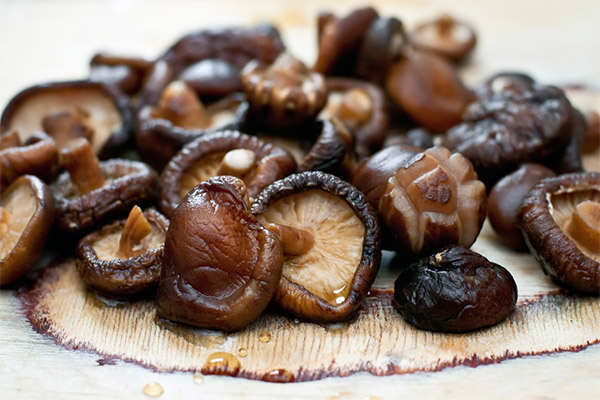
In China, Shiitake is most appreciated, as they are the basis of the national dish, loved by the monks who fill the Buddhist temples. Mushrooms are combined with other exotic ingredients. Nobody has managed to repeat the “Delight of the Buddha” dish outside the country.
You can get the maximum benefit by eating raw shiitake, but not everyone is able to appreciate their original taste. Most often, mushrooms are fried over high heat with the addition of salt and served with rice or vegetables. Shiitake are stewed in sour cream sauce.
A small amount of water is used for cooking shiitake, they are thrown into boiled water with dill seeds and garlic. The processing time is 3 minutes, after which you should remove the pan from the heat and let the mushrooms stand under a closed lid.
Note! Prolonged heat treatment shiitake deprives the taste and makes them tough. Therefore, it is important not to digest them.
After cooking mushrooms, you can take as a basis for preparing soups with a unique rich aroma.
In the case of dry shiitake, they are soaked before cooking. In this case, the leg is most often cut off, and the hats are poured with water and set for 12 hours for swelling. You can soak the mushrooms in a marinade prepared with soy sauce, garlic, pepper, lemon juice and sesame oil. When stewing shiitake, you can add marinade during cooking or use it as a component of the sauce.
Shiitake Pickled
To prepare the shiitake pickled, you should take:
- fresh mushrooms - 500 grams;
- salt - 2 tablespoons;
- mustard seeds - 2 tablespoons;
- cloves - about 5 pieces;
- dill - 5 umbrellas;
- bay leaf - 1 piece;
- wine vinegar - 4 tablespoons.
Marinated mushrooms without legs. First they need to be boiled in two liters of water for a quarter of an hour. In another container, prepare the marinade by mixing the remaining components in boiled water. Then mix the boiled mushrooms with marinade in a glass or plastic container, depending on the intended shelf life. The pickling process takes three days, but the most intense taste and aroma of shiitake acquire in a week.
Legs left after preparing for pickling can be used to make soup.
Crisps
Shiitake mushroom chips are a fragrant and savory treat. For their preparation, you should take large mushrooms. They are cut into plates, salted and sprinkled with spices to taste. Chips are fried in batter, which can be used as a regular batter of liquid consistency. The plates are fried separately after dipping in deep fat. Before serving chips need to be wet to remove excess oil.
Pilaf with Shiitake
Pilaf with shiitake - a spicy oriental dish. To prepare it, you need to take 2 cups of rice, preferably round, carrots and onions, salt, oil and a dozen shiitake in dried form. Add spices to taste by mixing at least 3 different ones. Before cooking, rinse and soak the mushrooms for several hours in cool water. Pilaf can be cooked in a wok or pan with a thick bottom. Pour rice and cook separately first. Cut carrots, onions and mushrooms into thin strips or slices. In the rice with water that boiled in a pan, dip the vegetables and mushrooms in turn, wait for it to boil, then add spices and salt.
Wait for boiling in a flame of high intensity, and then simmer on low heat for about 10 minutes. Once ready, set the pan aside and let stand for another 10 minutes. Stir before serving.
Is it possible to eat raw shiitake
Many experienced raw foodists eat fresh shiitake for food daily.However, the use of these mushrooms should be guided by the reactions of the body. Do not immediately switch to a mushroom diet, you should accustom the body to shiitake by eating minimal portions. Nutritionists recommend that newcomers to eating mushrooms the first few months to eat them carefully.
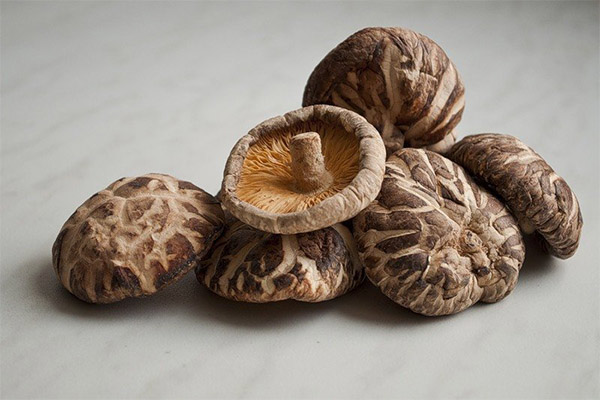
The rich vitamin composition of shiitake, which is transmitted as much as possible through the use of raw, can strengthen strength. Nevertheless, prudence is the main key to the formation of a healthy body reaction to shiitake.
Interesting Shiitake Facts
- Shiitake grown on rice husks are not suitable for use in the preparation of medicines. The scarcity of the substrate for growing does not allow the culture to reveal its nutritional potential to the maximum.
- Despite the fact that Japanese mushrooms contain a large number of active components, they in no way affect the reproductive or genitourinary system.
- Due to the content of chitin, shiitake digest in the stomach with great difficulty. So expect to eat plenty of mushrooms alone is not worth it.
- The secret ingredient of ancient geisha cosmetics was shiitake. The powder from these mushrooms was added to creams, lotions, and even hair products. Thanks to this component, the priestesses retained elasticity of the face and body skin, and silkiness of the hair.
- Vitamin B6, contained in one mushroom, is half the daily norm for the body, and the content of B5 exceeds the daily requirement by four times.
- Shiitake contains a large amount of vitamin D (more than 30% of the norm per day).
- According to the content of the antioxidant L-ergotionein, analogues of which have not yet been found by activity, shiitake bypassed the liver of chickens and wheat germ. Researchers are still unsuccessfully trying to find a source of ergotionin that would squeeze the Japanese mushroom.
- Kojic acid is a substance formed during the metabolism of fungi. Since the early 2000s, it has been part of the cosmetic cream from the Chanel fashion house. It is noteworthy that the product is very popular and has a noticeable lifting and nourishing effect.
- Chinese folk healers equate shiitake with ginseng root in importance, thereby recognizing its tremendous healing potential.
- The history of using shiitake dates back more than 2 millennia, and ancient recipes are still used in many Asian regions to this day.
- Cultivation of fungus cultures in artificial conditions started in the 40s of the 20th century. And until that time, all stocks of mushrooms were represented by forest crops collected by people.
- Even with poor nutrition, you don’t have to worry about a lack of vitamins if you use shiitake. Their rich composition is able to maintain normal body functions over time.
- Mushroom-based tinctures of oil can be used by most people who are allergic to an alcohol counterpart.
- Asia currently produces only 20% of the world's shiitake stock.
- Fans of mushroom culture also consider themselves Canada and the northern part of the United States. Perhaps this is due to the climate, since in the conditions of prolonged winters it is extremely important to enrich the diet with products with high nutritional value. From this position, shiitake are an excellent source of maintaining health.
- Shiitake is also popularized in Australia. Dry mushrooms and powder, which is used for cosmetic purposes, accounts for a large share of consumption.
- Mushroom-based Japanese extreme diet allows you to lose 3-5 kg per week. However, so that the lost kilograms do not return, nutritionists recommend stopping on a more sparing diet and playing sports.
Ancient traditions and recipes for the use of shiitake have come to the present almost in its original form. This constancy may be evidence that the nutritional and healing properties of the culture are not in doubt. A growing number of adherents of a healthy lifestyle are introducing shiitake into the diet.Large manufacturers of food and cosmetic products are also not far behind.
«Important: all information on the site is provided exclusively in fact-finding purposes. Before applying any recommendations, consult with a profile specialist. Neither the editors nor the authors are liable for any possible harm caused materials. "

